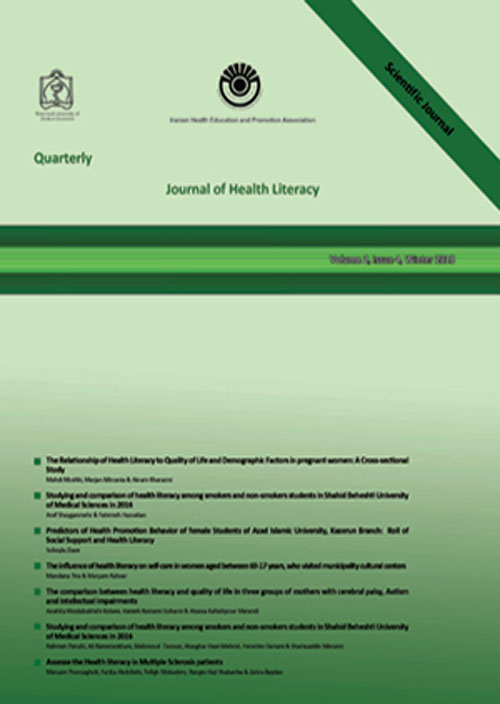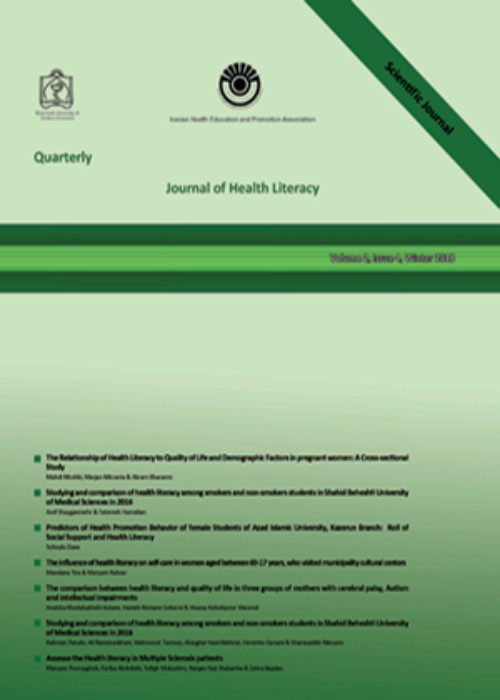فهرست مطالب

Journal of Health Literacy
Volume:6 Issue: 3, Autumn 2021
- تاریخ انتشار: 1400/09/24
- تعداد عناوین: 7
-
-
Pages 9-23Background and ObjectivePeople with hearing impairments have not accessed well to health information sources compared to people with normal hearing. The study aims to show the status of electronic health literacy in persons with hearing impairments.Materials and MethodsThe methodology was content analysis based on of Graneheim, B. Lundman’s pattern. Thirty-five participants with hearing impairments and 14 persons with normal hearing were selected. Sampling started with the purposive method and continued until data saturation. A total of 76 semi-structured interviews were made and analyzed using MaxQDA 10.4.15.1.ResultsThe current state of electronic health literacy in people with hearing impairment was emerged as a theme, included three main categories contains poor electronic health literacy, underlying causes for poor electronic health literacy, and consequences of low electronic health literacy in persons with hearing impairment. Poor electronic health literacy consists of poor online health information seeking skills, poor understanding, and processing of online health information, and poor evaluation of online health information. Four main subcategories for poor electronic health literacy were unequal access to conventional health information, incongruous health communication, lack of considering persons with hearing impairment in producing health education programs, and poor electronic health information sources for persons with hearing impairment. In addition, consequences of low electronic health literacy are composed of two subcategories, including reliance on available information sources and the promotion of misconceptions in the deaf community.ConclusionLow theoretical and applied knowledge about various aspects of health might be the main factor in people with hearing impairments that influences their nature of deafness and obstacles to access health information sources Online content generation fitting the needs of those persons recommended creating access to health information for them. In addition to this, the development and enhancement of information searching skills, understanding and processing, evaluation, and use of online health information are essential.Keywords: Electronic Health Literacy, Persons with Hearing Impairments, Health Literacy, health promotion, Communication
-
Pages 24-31Background and ObjectiveHealth literacy and health-promoting behaviors are the main factors in field of health promotion and education and play an important effect to prevent diabetes type II complications and reduce its health care costs. Therefore, this study aimed to find the relationship between health literacy and health-promoting behaviors in patients with type II diabetes.Materials and MethodsThis correlational study was conducted on 175 diabetic patients (20 to 65 years) from April 2020 to October 2020. Convenience sampling was used to select eligible diabetic patients who were referred to governmental diabetes clinics in Ganjavian Hospital where located in Dezful city, Iran. Data were collected by diabetic patients’ health-promoting behaviors questionnaire and health literacy questionnaire. Data were analyzed using SPSS 22, descriptive statistics, and Pearson’s correlation coefficient.ResultsThe mean scores for health literacy and health-promoting behaviors were 113.54 ± 25.66 and 171.7 ± 33.69, respectively. The highest scores in health-promoting behaviors belonged to blood sugar control and foot control and the lowest score belonged to physical activity. There was a significant relationship between all dimensions of health promoting behaviors and health literacy (P = 0.000, r = 0.444).ConclusionSince there is a positive relationship between health literacy and health-promoting behaviors, there is a need for more efforts in teaching health-promoting behaviors and publicizing self-care. Further, adding these concepts into course plans may lead to the health improvement of community members.Keywords: health behaviors, Health Literacy, Type II diabetes mellitus
-
Pages 32-46Background and ObjectiveOne of the necessities of the information age is the need for education, especially in the field of media literacy. This study aimed to determine the effect of educational programs on media literacy of medical students of Shahid Sadoughi in Yazd in 2020.Materials and MethodsAn experimental study was conducted through a stratified random sampling design on 88 students (44 in the experimental group and 44 in control) of Shahid Sadoughi University of Medical Sciences, Yazd. The educational program was implemented using storyline software, and educational messages were sent to the students of the experimental group during 10 sessions. The data collection tool was a media literacy questionnaire that was completed before intervention and two months after the training program. The paired t-test and independent t-test were used to express analytical indices. All analyzes were performed in SPSS software version 26 and level of 5% was considered as significant level.ResultsThe results of the chi-square test between demographic characteristics in the control and experimental groups showed that the two groups were identical in terms of study variables (p> 0.05). Before intervention, the mean scores of all variables in the control and experimental groups did not differ significantly (p> 0.0 5), while the mean scores of "critical thinking", "production ability", "analysis ability" and "familiarity with media abbreviations" were significantly changed in the two groups (p = 0.001) after intervention.ConclusionAccording to the obtained results, education raises the level of media literacy in using the virtual world. It is suggested that the reasons for the lack of growth in media literacy in Iran need the further investigation. Considering media knowledge as the main course in educational programs of students is essential to promote their media literacyKeywords: media literacy, medical students, Educational program
-
Pages 47-54Background and Objective
Oral health literacy (OHL) is a type of health literacy that specifically focuses on people`s literacy and knowledge about oral health. It has been shown that oral health literacy can be a powerful predictor of people's health, health-related behaviors, and medical outcomes. As parents play a crucial role in their child`s health, in this study we aimed to assess the oral health literacy of the adults and its relation with their children`s dental status.
Materials and MethodsFour hundred parents with their children participated in this cross-sectional study. Two hundred OHL questionnaires were distributed to parents of 3–6-year-old patients referred to pediatric hospitals for any reason. The OHL was assessed in three domains: reading comprehension, numeracy and appropriate decision-making. The score were categorized as inadequate, 0-7; marginal, 8-9, and adequate, 10-15. Then a dentist did the dental examination of their children, and the DMFT (decay-missing-filled teeth) index was calculated. Chi-square, independent sample t-test, Mann-Whitney, and Kruskal-Wallis tests were used for comparative analysis.
Results69.2%, 21.2% and 9.6% of the parents had inadequate, marginal and adequate OHL, respectively. The mean DMFT was 4.5±4.47 (median:3) with minimum of 0 and maximum of 17. The mean age of parents and children did not differ between 3 groups of OHL, but DMFT was significantly higher in participant with inadequate OHL (p=0.03). The mean DMFT was also higher in families with greater than four family members(p=0.002). It is shown that the frequency of inadequate OHL was higher among parents with lower education(p=0.002), while the DMFT did not differ in 3 groups of education(p=0.84).
ConclusionParents with inadequate OHL was associated with high children’s dental caries. So, conducting oral health education for parents is essential. Holding training classes in health centers can improve the parent’s oral health literacy, and hopefully motivate them to look after their child’s dental health.
Keywords: Oral Health, Health Literacy, Child -
Pages 55-63Background and ObjectiveDiabetes is a chronic disease that can cause acute and debilitating complications such as cardiovascular disease, blindness, and kidney failure. Inadequate self-care and health literacy are major barriers to diabetes management and affect patients' participation in self-care activities. This study aims to evaluate the patient's health literacy status with type 2 diabetes in three areas of function, communication, and criticism and to determine the relationship between these factors and self-care behaviors in patients with diabetes.Materials and MethodsA cross-sectional study was conducted on 118 diabetic patients referred to diabetes clinic 2019 through a regular random sampling approach. The level of health literacy and its subscales in patients was assessed by a Functional, Communicative, and Critical Health Literacy standard questionnaire. In order to analyze the data, descriptive statistics including mean, standard deviation, and frequency and analytical statistics such as independent t-test and one-way analysis of variance, Chi-square test, and multivariate linear regression were performed by SPSS software version 16.Resultsthe mean score for total health literacy was 25.51±5.7, which is rated as average. The results showed a significant relationship between functional health literacy and communication health literacy (r = -0.481), communicative and critical health literacy (r = 0.726), and between functional and critical health literacy (r = -0.426). Total health literacy had a statistically significant relationship with functional health literacy (r = 0.456), communication (r = 0.496), and critical health literacy (r = 0.534).ConclusionsConsidering that communication, critical and functional health literacy is related to total health literacy and preventive behaviors in diabetic patients, treatment seems necessary.Keywords: Health Literacy, diabetes type2, Chronic illness
-
Pages 64-77Background and ObjectiveAdolescence is one of the most important periods of life. Adolescents living in Orphanages are more exposed to health risks. One of the factors influencing health in Adolescence is health literacy and the health-related quality of life. This study aimed to compare health literacy and health-related quality of life between Orphan and Normal Adolescents.Materials and MethodsIn this cross-sectional descriptive study, 72 Orphanage adolescents and 160 adolescents at home were selected from Tehran Province through cluster sampling from Sep 13, 2020 to Jan 9, 2021. The data was collected using adolescents’ health literacy (HELMA) questionnaire and HRQOL (Kidscreen-27) questionnaire. In order to analyze the data, ANCOVA, Chi-square test, Independent Samples t-test, Fisher's exact test, and Mann-Whitney test were used in SPSS 22.ResultsThere is no significant difference in health literacy among the two groups (p=0.84) and only in the subclass calculation, Orphanage adolescents obtained a significantly higher score (p=0.007). There was also no significant difference in HRQOL between the two groups (p=0.11). However, in the subclasses school environment (P=0.03) and psychological well-being (p=0.01) adolescents at home and in the subclass social support and peers (p=0.02) Orphanage adolescents gained significantly higher scores.ConclusionDespite the special conditions of Orphanage adolescents, the health literacy and HRQOL were not significantly different between the two groups. In the subclass calculation of health literacy, Orphanage adolescents obtained a significantly higher score and the subclasses of HRQOL, school environment, and psychological well-being adolescents at home, and the subclass social support and peers Orphanage adolescents gained significantly higher scores.Keywords: Health Literacy, Health-Related Quality of Life, Adolescents, Orphanages, residential Facilities
-
Pages 78-85Background and Objective
Health Literacy is the capacity of individuals to obtain, interpret, and understand health-related information for making an appropriate decision. The aim of this study was a systematically review the literature on the outcomes of health literacy in Iranian adolescents.
Materials and MethodsThe search was done on scientific databases, using the keywords "health literacy", "health knowledge", "teen", " adolescent", high school"," middle school" and "Iran" in Persian and English, from 2010 until 2021 Jan. Study process was conducted from 10th of December to the end of December. Studies were considered with data about outcomes of health literacy in Iranian adolescents.
ResultsTen studies met inclusionary criteria. Two studies reported students with higher health literacy had better health-promoting behaviours; moreover, two other studies reported students with higher health literacy had better body mass index. One study reported better oral health literacy conducted to lower oral health problems; furthermore, one study showed that higher health literacy leads to osteoporosis preventive behaviours. Results of one study indicated that higher health literacy leads to more perceived self-efficacy and better self-care performance. One study showed better hair and skincare performance in students with higher health literacy. Another study indicated that students with higher health literacy had better attitude and behaviour toward breakfast consumption and the results of one study demonstrated that students with better health literacy had better nutrition behaviours. In all studies, there were statistically significant linear correlations between health literacy and its outcomes (p<0.05).
ConclusionThe results indicated that adolescent's health literacy seems associated with important health outcomes then considering the importance of health literacy in adolescents, designing and implementing educational intervention for promoting health literacy is significantly important. As adolescents spend most of their daily time in schools, educational interventions should be school-based.
Keywords: Adolescent, Health Literacy, Iran


